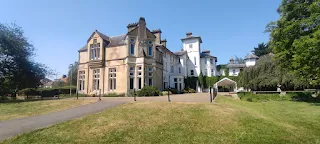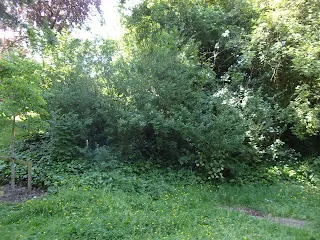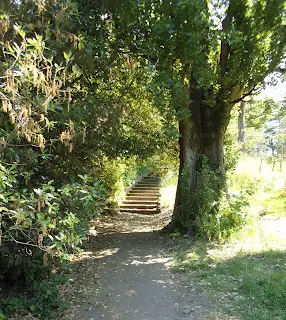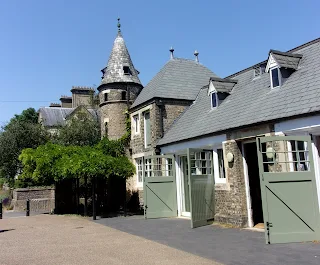This is a bit of a misnomer, as only people attending events can actually go inside Stephens House- I just went for a meander around the gardens. It's free to enter and we walked from Finchley Central station and entered through the Holmwood Gate.
Stephens House (also known as Avenue House) was built in 1859. It was acquired in 1874, by Conservative politician and ink magnate Henry Charles "Inky" Stephens (1841-1918). His father, Dr Henry Stephens (1796-1864) had, in 1832, invented what became known as "Stephens' Ink"- an indelible blue-black writing fluid.
On his death Stephens bequeathed the estate to Finchley Urban District Council. Commercially, the ten acre garden and house have been known as Stephens House and Gardens since 2014.
Events frequently happen here, and the house can be hired for wedding celebrations, parties, conferences and meetings.
This shot was taken by the SuperDean.
We stumbled across the water tower, which is a magnificently statuesque construction- albeit in a derelict state- dating from 1880. It is octagonal in shape with a crenelated top and once serviced the house.
The first thing we did was enter the Bothy Gardens, as they're only open for a limited amount of time (Friday mornings only). As you can see, it was a brilliantly sunny morning.
The building behind houses the Terapia. No, it's not a spot where terrapins live(!) Rather, it is a provider of training for psychotherapeutic services.
The walls are castellated, like those of the water tower, and both are early examples of the use of reinforced concrete. You can spot roses rambling around the arbour even though the photo is in silhouette.
The Bothy site was originally designed by Robert Marnock and constructed between 1878 and 1882.Some of the flowers planted here are just lovely, like these purple delphiniums, although I'm not sure what their droopy little white friends at the bottom are...
Mini-fountain spouting from the stone rockery in this flower bed. The area was considered experimental; in that Henry Stephens strived for the whole estate to be self-sufficient.
A pretty, rustic seat, and the gardeners were hard at work irrigating the Bothy...
The Bothy site was intended as a kitchen garden serving the house, but at one time fish ponds, glasshouses, a dairy, a section for farriers and housing for estate workers could all be found within it.
As well as a stable of horses, the estate also housed a flock of sheep and a herd of highland cattle; hence the additional need for an abattoir. The farm ceased being after Stephens' death in 1918, and became the park keeper's accommodation.
Badly neglected since 1984, when the last keeper left, and now purely aesthetic, the Bothy is now maintained by dedicated volunteers.
Alliums bowing down in the brilliant sunshine...
We walked through the Middle Green towards Monkey Hill- although I didn't see any monkeys there...😉🐒
Monkey Hill makes up part of the arboretum, and a huge variety of trees thrive in the gardens...
Rambling stairs, and a lot of the species of trees were brought here by Henry "Inky" Stephens himself, as opposed to being included by Robert Marnock, the garden's designer.
The wild view from the steepest part of Monkey Hill, and the gloomy greenness here is wonderfully cooling on a hot day.
The Lower Green is a wonderful place on which to exercise, or just sit and relax. It was quite quiet when we visited.
It's hard to read the plaque with this statue that sits near the café, but it looks like it's called Loving Grace, and is fairly new; dating from 2018.
A pretty rose pergola, taken from the café veranda...
The café- situated in what was formerly the stables- serves a pleasant variety of food and drink, although we weren't hungry so didn't bother hanging around...
The little wooden jetty overlooking the pond, and we sat here just the other side of the railings relaxing on a bench. I always find being near water very calming.
Peer hard and you might just be able to make out the fish twirling around in the pond...

We strolled around the pond, with evidence of maintenance being carried out. Indeed, the gardens are very well cared for and a credit to their team.
Lily pads on the pond. Off-subject but still on the topic of water, there is known to be a well in the basement of the house. It is 14m deep, and I would relish the chance to go inside the house and nosey around!
The perfectly groomed Rockery...
This cascade from an area known as the Dell- which was once a Bog Garden fed from their Water Tower harvesting and irrigation system- feeds the pond...
Walking up stone steps to the Dell. This was another beautifully cool area.
One of the reasons its previous incarnation is known is because a Swamp Cypress Tree thrives here, and this is particularly tolerant of very damp sites...
The aim is to reintroduce the irrigation system so that it operates as intended by "Inky" Stephens...
This area was once permanently damp, so the plants which thrived here would have had to have been of the moisture-loving variety.
This was another part of the garden which was peaceful, with sunlight shooting through the trees...
At the top of the rumbling Dell cascade...
Scenic, modern steps down towards the pond...
A Conversation With Spike, 2014, by John Somerville sits in the gardens.
Terence Alan "Spike" Milligan (1918-2002) was considered the godfather of alternative comedy, and this statue was put in the gardens by The Finchley Society, of which Spike was president.
The bench contains seven elements related to this comic genius's work and personality.
The elephants on the arms of the bench refer to the fact that Spike was born in India, whilst his father was a sergeant major in the British Indian Army. He also lived in British Burma.
Spike (who called himself Spike because he disliked his first name) named himself after Spike Jones, an American musician and bandleader, after hearing him on the radio. Spike Jones' vocal style was quite outlandish, and his music featured popular ballads with the addition of whistles, gunshots, burps and hiccups (amongst other things!)
This fairy represents the fact that Spike had a lifelong fascination with fairies.
The soldiers represent Spike's time in the army, during World War II. The heads of the four main Goons characters: Eccles, Bluebottle, Major Bloodnok and Eddie Seagoon all sit along the bottom of the backrest.
The comedy and tragedy masks are not just for theatrical reference. They represent the fact that although Spike was a comedian, he suffered from manic depression for most of his life.
The three characters at the bottom are Spike with his Goon Show co-stars Harry Secombe and Peter Sellers.
A close-up of the funny trio. This doesn't quite show all three of them- oh well, there's my excuse to go back sorted!😁
The letter Q sits on both ends of the bench, crafted like foliage, to represent several BBC series of that name made by Spike. As its title suggests, the statue invites you to sit with Spike, and chat awhile...
Leaving the gardens, and you can tell this area was once the stables. I quite like the "witchy" turret- gothic little moi would!
The SPIKE FOR PRIME MINISTER photo (displayed in the window as we left) comes from an early 1960s advertisement for Dairy Crunch chocolate bars. In what is considered a valid satirical point, Spike Milligan took the view that the world was run by idiots!
The Catcher In The Rye pub, which we passed as we made our way back to the Tube station. Named after the novel, I've never read J.D. Salinger's homage to adolescent angst and alienation, but maybe I should- it's a theme that has certainly inspired my stories.
Stephens Gardens, I will return, and I'd love the opportunity to go inside Stephens House one day.
Until then,
TTFN
Miss Elaineous
XXXXXXXXXXXXX
XXXXX
X














































.jpg)



